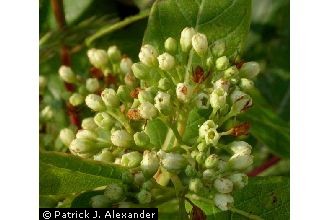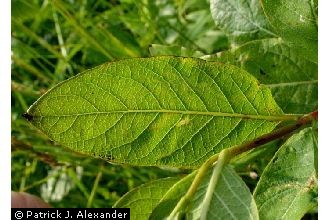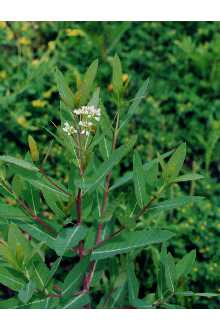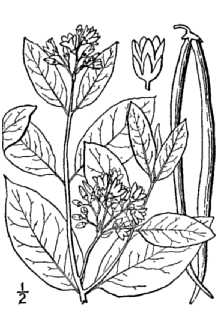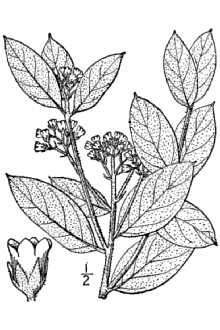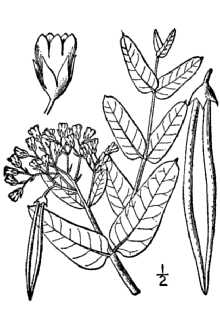Indianhemp
Scientific Name: Apocynum cannabinum L.
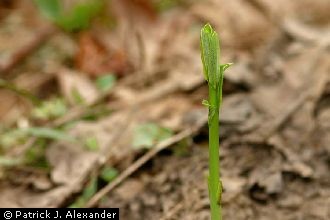
| General Information | |
|---|---|
| Usda Symbol | APCA |
| Group | Dicot |
| Life Cycle | Perennial |
| Growth Habits | Forb/herb |
| Native Locations | APCA |
Plant Guide
Alternate Names
Dogbane, milkweed, honeybloom, bitter root, black hemp, hemp dogbane, lechuguilla, westernwall
Uses
Warning - Indian hemp can be toxic if ingested without proper preparation. Ethnobotanic: Indian hemp is harvested for fiber. The stems are cut in the fall; they are then split open and the long, silky fibers removed. The fibers are then twisted into string, which provides cordage. String, thread, rope, baskets, snares, netting, and clothing were made from the bast fibers of the Indian hemp plant because they are so silky yet strong. Cordage was then used to make tump straps, belts, netted bags, hairnets, and ceremonial regalia (capes, skirts, and head-dresses). The fiber was particularly useful in making fishing and carrying nets, for string and for ropes, and to some extent for weaving rough cloth. In California, Indian hemp and milkweed are used somewhat interchangeably for cordage. The Luiseño of southern California for their dance regalia used Indian hemp; the golden eagle or other feathers are tied to netting for the dance skirt for men (Merriam 1955). The wild hemp was also used by the Chemeweve for snares for otter and rabbits (Ibid.) Alfred Brousseau © Brother Eric Vogel, St. Mary's College @ CalPhotos Dogbane is very important to tribes in the Columbia Plateau in Washington, Oregon, and Idaho for basketry. The Quinalt, Kalispel, Nez Perce, Spokane, Umatilla, Wasco, Wishram, Yakima, and Klikitat used dogbane for cordage and basketry. Families use the native twine to tie together the frames for their winter lodges. They used it to sew cattails and tules into sturdy mats to cover these frames and to serve as carpeting, furniture, beds, and utensils. Dip nets, set nets, and seines were made of dogbane. The nets were strong enough to hold the giant sturgeon caught in the Columbia River. Of all the important uses for Indian hemp, the itatamat , or "counting the days" ball, was perhaps the most significant for the people themselves. From the time of her marriage, a woman would record a calendar of her life's events by tying knots on a length of hemp as important events occurred. She marked births, deaths, and other extraordinary days with beads, shells or other talismans. When the ball got too large to handle easily, she started a new ball. Flat twined bags ("sally bags"), round twined bags and basketry caps were made with dogbane. Soft bags were made using twine from Indian hemp or milkweed decorated with cornhusk imbrication. Basket bottoms and top margins were of woven cedar bark. These soft bags conform to the shape of a load of roots of camas or other plants. Later explorers reported that the Nez Perce and other tribes stored berries, roots, and nuts in bags about one by two feet, and used larger bags up to three feet long for clothing and other personal effects. Early visitor to the Mid-Columbia also described piles of filled bags in the corners or hung along the wall in native homes. One weaver estimated that it took two to three months to twine a large root-storage bag. As a medium of trade, barter, or wager, the bags in the early days were considered only the wrapping or container for the dried roots they held. The largest of the bags would hold just under a half-bushel or nearly four dry gallons of camas or bitterroot bulbs. Now, the bags themselves are highly valued as trade items. The flat twined bags have been widely traded to other tribes, such as the Crow and Blackfeet of Montana. Today, the wapanii sapk'ukt, or "twined handbag," is the most popular form of flat twined bags. It is carried with great pride as part of ceremonial regalia, the twined handbag emphasizing the distinct cultural heritage of the person who carries it. Today, cotton twine usually replaces Indian hemp in basketry; however, very special ceremonial bags are still made with Indian hemp. The biochemical constituents in Indian hemp are apocynin, apocynamarin, cymarin, and and rosin. Indian hemp could be dried, crushed, and then snuffed for coughs in head colds. The root was made into a tea and was used to help a baby’s cold, earache, headache, nervousness, dizziness, worms and insanity. This tea was also taken for heart palpitations, but care should be observed if using it for cardiac disorders. It acts as a vaso-constrictor, slows and strengthens the heartbeat, and raises blood pressure. The root could also be used as an emetic, diaphoretic, antispasmodic, cathartic, anodyne, hypnotic, laxative, treats vomiting, diarrhea, hydrocephalus, urinary difficulties, dropsy, jaundice, liver problems, and stimulates the digestive system. It has been successfully employed for alcoholism. A wash made of crushed root can be shampooed into the hair to stimulate growth, remove dandruff and head lice. The milky juice can remove warts. A poultice of the leaves reduces tumors, hemorrhoids, and inflammation of the testicles. The poultice placed over the eyelids works on opthalmia and eye diseases. The leaves ground into powder can dress wounds, sores and ulcers. Erosion Control: The extensive root system on Indian hemp provides good slope and streambank stabilization and erosion control functions. The flowers are attractive to bees, butterflies, and other insects. The plant itself is toxic; so many forms of wildlife do not eat it. Indian hemp is considered a noxious weed because of its invasive nature and its toxicity to domestic livestock. Invasive Potential: This plant can be invasive in orchards and cultivated areas, so is not a garden plant. The small, inconspicuous flowers and weedy growth form doesn't have horticultural appeal.
Status
Please consult the PLANTS Web site and your State Department of Natural Resources for this plant’s current status and wetland indicator values.
Description
General: Dogbane Family (Apocynaceae), The plant stem can be 0,61-1,83 m (2-6 feet) tall, and contains milky juice, The elliptical leaves are small, about 5,0-7, Use soil moisture sensors to measure the soil moisture of Indianhemp.,6 cm (2-3 inches) long, and opposite, The flowers are small and inconspicuous, cylindric to urn-shaped, and greenish pink, The fruit is 6 - 9 cm (2,4-3,5 cm) long and pendant, slender and cylindric, When the fruit matures and splits open, the seeds are wind dispersed with long tufts of silky hairs,
Distribution
For current distribution, please consult the Plant Profile page for this species on the PLANTS Web site. Indian hemp or dogbane proliferates in moist places near riparian areas along streams, springs, levees, roadsides, and waste places. This well-known source of fibers is found in damp places, below 5,000 feet altitude through most of California, even here and there in the deserts. Indian hemp grows throughout California north to British Colombia and east across the United States. Indian hemp is found near the borders of woods, along paths, in clearings, or in disturbed, waste places like ditches. It is no longer very common in California, and many traditional gathering sites are gone.
Establishment
Indian hemp plants are not widely available. Transplanting bare rootstock or collecting seed for direct reseeding into the ground will be necessary in most areas. Use of plants which have been traditionally used by the ancestors of that place, and which are adapted to the climate, soils, and site conditions of that place, is optimum. Seed Collections: Collect seeds after pods have ripened, but before they have split open. This usually occurs in late summer, from August to September. The seeds are wind dispersed, so be careful when gathering to place them in a paper or burlap bag to avoid losing them. Seeds can be directly sown into the ground in the fall. The seed is very viable. Planting seed the first fall after collecting seeds maximizes revegetation success. It is not certain how long you can store the seeds. Irrigation the first summer after planting will improve plant survival. Once root are established, extra watering will be unnecessary. Indian hemp is fairly aggressive, and will usually out-compete other plant species on its own. The latex in stems and leaves protects the plant from most herbivores. Live Plant Collections: Plants can be divided almost any time of year, but revegetation is most successful in fall after the plants senesce. Harvest and planting of Indian hemp is optimum in October, or just after the first fall rains. Stalks should be cut to a conveniently manageable length before digging up plants (approximately 25 to 35 cm). No more than 1/4 of the plants in an area should be collected; a depth of 15 cm (6 in) is sufficiently deep for digging plugs. This will leave enough plants and roots to grow back during the following growing season. Live transplants should be planted as soon as possible. Plants should be transported and stored in a cool location prior to planting. Plugs may be split into smaller units, generally no smaller than 6 x 6 cm (2.4 x 2.4 in) with healthy roots and tops. Weeds in the plugs should be removed by hand. For ease in transport, soil may be washed gently from roots. The roots should always remain moist or in water until planted. Roots should be kept moist after the plants have been dug up. Planting should occur at a spacing of approximately one-foot centers. Plants should be watered in. Irrigation may be necessary through the first dry season. By the second year, roots should have extended to the water table and irrigation should no longer be necessary.
Management
When used for fiber, Indian hemp is collected in the autumn after the leaves have begun to senesce or dry up and the stalks turn a deep reddish brown color. Plants are cut at the base of the stem. Cutting the plants appears to stimulate new growth in the spring; so as many stalks as possible are cut. Plants are then split open and the fibers removed and processed into cordage. After winter, the fibers have disintegrated and the stems are still standing, but full of mush or empty. The fibers can't be removed after one winter. There are only two known large sites for traditional harvest of Indian hemp for fiber in California; one at Yosemite and one near Santa Rosa. In the Columbia Basin, though Indian hemp might be found in many low-lying areas, certain stands of hemp grew higher and straighter, and the long strands produced were prized for the strength of the twine made from them. So special was this resource area that violent conflict (otherwise uncommon) occurred between Wanapam Sahaptins and Columbia Salish over access to the hemp (Relander 1956) Vast quantities of fiber plants are required for nets, regalia, and cordage. Blackburn and Anderson (1993) quote Craig Bates of the Yosemite Museum that it takes approximately five stalks of milkweed or Indian hemp to manufacture one foot of cordage. A Sierra Miwok feather skirt or cape contain about 100 feet of cordage made from approximately 500 plant stalks, while a deer net 40 feet in length (Barrett and Gifford 1933:178) contained some 7,000 feet of cordage, which would have required the harvesting of a staggering 35,000 plant stalks. Therefore, propagation and conservation of this species for fiber is very important for production of traditionally manufactured cordage, which is still used today. Both milkweed and dogbane are burned in the fall to eliminate dead stalks and stimulate new growth. Burning causes new growth to have taller, straighter stems (with longer fibers). It also stimulates flower and seed production. Cultivars, Improved and Selected Materials (and area of origin) APCA is available from native plant nurseries within its range.
Plant Traits
Growth Requirements
| Temperature, Minimum (°F) | -43 |
|---|---|
| Adapted to Coarse Textured Soils | Yes |
| Adapted to Fine Textured Soils | Yes |
| Adapted to Medium Textured Soils | Yes |
| Anaerobic Tolerance | Medium |
| CaCO3 Tolerance | Medium |
| Cold Stratification Required | No |
| Drought Tolerance | Medium |
| Fertility Requirement | Medium |
| Fire Tolerance | None |
| Frost Free Days, Minimum | 100 |
| Hedge Tolerance | None |
| Moisture Use | High |
| pH, Maximum | 7.0 |
| pH, Minimum | 4.5 |
| Planting Density per Acre, Maxim | 11000 |
| Planting Density per Acre, Minim | 3100 |
| Precipitation, Maximum | 60 |
| Precipitation, Minimum | 15 |
| Root Depth, Minimum (inches) | 12 |
| Salinity Tolerance | None |
| Shade Tolerance | Intermediate |
Morphology/Physiology
| After Harvest Regrowth Rate | Slow |
|---|---|
| Toxicity | Severe |
| Resprout Ability | No |
| Shape and Orientation | Erect |
| Active Growth Period | Spring and Summer |
| Bloat | None |
| Coppice Potential | No |
| Fall Conspicuous | No |
| Fire Resistant | No |
| Flower Color | White |
| Flower Conspicuous | No |
| Foliage Color | Green |
| Foliage Porosity Summer | Porous |
| Foliage Porosity Winter | Porous |
| Fruit/Seed Color | White |
| Nitrogen Fixation | None |
| Low Growing Grass | No |
| Lifespan | Moderate |
| Leaf Retention | No |
| Known Allelopath | No |
| Height, Mature (feet) | 3.3 |
| Growth Rate | Moderate |
| Growth Form | Single Stem |
| Fruit/Seed Conspicuous | No |
| Foliage Texture | Medium |
Reproduction
| Vegetative Spread Rate | None |
|---|---|
| Small Grain | No |
| Seedling Vigor | Medium |
| Seed Spread Rate | Moderate |
| Fruit/Seed Period End | Fall |
| Seed per Pound | 500000 |
| Propagated by Tubers | No |
| Propagated by Sprigs | No |
| Propagated by Sod | No |
| Propagated by Seed | Yes |
| Propagated by Corm | No |
| Propagated by Container | No |
| Propagated by Bulb | No |
| Propagated by Bare Root | Yes |
| Fruit/Seed Persistence | No |
| Fruit/Seed Period Begin | Summer |
| Fruit/Seed Abundance | High |
| Commercial Availability | No Known Source |
| Bloom Period | Summer |
| Propagated by Cuttings | No |
Suitability/Use
| Veneer Product | No |
|---|---|
| Pulpwood Product | No |
| Post Product | No |
| Palatable Human | No |
| Palatable Graze Animal | Low |
| Palatable Browse Animal | Low |
| Nursery Stock Product | No |
| Naval Store Product | No |
| Lumber Product | No |
| Fodder Product | No |
| Christmas Tree Product | No |
| Berry/Nut/Seed Product | No |

